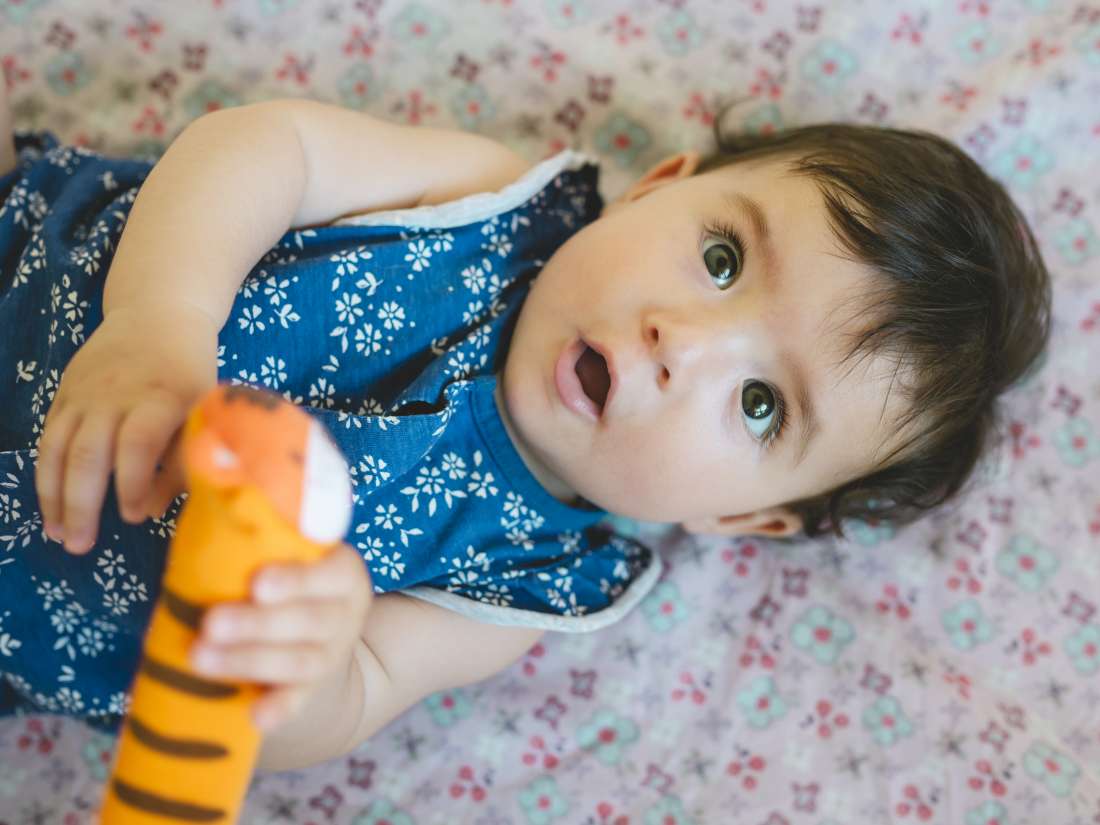The Moro reflex, or startle reflex, refers to an involuntary motor response that infants develop shortly after birth. A Moro reflex may involve the infant suddenly splaying their arms and moving their legs before bringing their arms in front of their body.
Doctors often check for the Moro reflex during the first few postdelivery examinations.
Continue reading this article to learn more about the Moro reflex, including its triggers and how to calm infants who experience the reflex.
Babies show several instinctive reflexes, including rooting, sucking, grasping, and stepping. Doctors will check for these reflexes during the first few postdelivery checkups.
The Moro reflex is another type of automatic response that newborn babies show when they become startled.
When something triggers the Moro reflex, a baby will extend their arms — moving them outward at the shoulder and then straightening them — and throw their head back. They will often also extend their legs as well as their arms, but leg movements differ among babies. The baby will then curl their arms and legs toward their body. A baby may or may not cry during the reflex.
Some babies have an abnormal Moro reflex that involves only one side of the body, while others may have no Moro reflex. Possible causes of an abnormal or absent reflex include:
- injuries from the birthing process
- infections
- muscle weakness
- spastic cerebral palsy
- peripheral nerve damage
Loud noises, intense light, and sudden movements can trigger a baby's Moro reflex. They can even trigger it in themselves when they move suddenly.
The sensation of falling can also be a trigger. A baby might feel as though they are falling when their parents or caregivers lay them down or pick them up.
Doctors may use the head drop method to check for the Moro reflex. During a head drop test, a doctor will simulate the sensation of falling by gently lowering the baby's head relative to their body.
The Moro reflex is present at birth. In the first 12 weeks after birth, babies may exhibit a full Moro reflex, which involves the arms, legs, and head.
Once the neck can support the weight of the head, at about 4 months of age, babies start having fewer and less intense Moro reflexes. They might only extend and curl the arms without moving the head or legs. The Moro reflex disappears completely when the baby is 6 months old.
Although the Moro reflex is a good sign in newborn babies, some babies have an overactive or exaggerated Moro reflex that can sometimes interfere with sleep.
In very rare cases, a severe Moro reflex may be a sign of hyperekplexia, an inherited neurological condition.
Infants who have hyperekplexia have exaggerated startle responses, which brief periods of muscle rigidity and paralysis follow. They also have increased muscle tone, called hypertonia, which makes the limbs stiff and difficult to move. People can consult their doctor if they see these symptoms in a newborn.
Otherwise, it is important to remember that the Moro reflex is a normal reaction in healthy babies and that it is not a cause for concern. The Moro reflex is especially strong in newborn babies as they adjust to the world outside the womb, but it usually does not bother them.
Parents and caregivers can comfort a baby who cries or seems distressed when experiencing a Moro reflex by:
- moving the baby's outstretched arms and legs gently toward their body
- holding the baby close until they calm down
- supporting the baby's head and neck when moving or holding them
- swaddling the baby in a lightweight cloth
The term swaddling refers to different methods of wrapping newborn babies in a lightweight blanket. Swaddling helps keep a baby's limbs close to their body so that they do not startle themselves while they sleep.
Here are some tips for swaddling a baby:
- Lay a large, thin blanket on a flat surface with one corner pointing up, so the blanket makes a diamond shape.
- Fold the top corner down.
- Put the baby face up, with their head and neck above the folded edge.
- Place the baby's left arm straight alongside their body.
- Fold the left side of the blanket across the baby's body, going under the right arm, and tuck it underneath their back.
- Place the baby's right arm straight alongside their body.
- Fold the right side of the blanket over the baby's body and tuck it underneath their left side.
- Fold the bottom corner up, but remember to leave a little room for the baby to move their feet.
Although swaddling is an age-old practice, it is a controversial topic among healthcare professionals, parents, and caregivers.
According to the National Institutes of Health (NIH), swaddling can increase the risk of sudden infant death syndrome (SIDS) if the baby rolls onto their stomach.
The NIH recommend that swaddled babies should sleep on their backs. The NIH also recommend that parents and caregivers stop swaddling babies who can roll over on their own.
Infantile spasms, or West syndrome, refers to a type of seizure that occurs in babies with epilepsy. Infantile spasms share some of the same features as the Moro reflex.
Infantile spasms can look different in different babies. Some babies will arch their back and extend their arms and legs, while others bend forward while their arms and legs stiffen.
Parents or caregivers who are concerned about the movements that their baby is making should take them to see a pediatrician, who should be able to distinguish between the Moro reflex and infantile spasms relatively easily in a newborn.
Infantile spasms usually start within the first year of life, between 4 and 8 months. They typically resolve by the age of 5 years, although other seizures may take their place. Babies can have up to 100 spasms per day.
Doctors can treat infantile spasms with hormonal therapy or antiseizure medication. However, these treatments can cause serious side effects. Babies who develop infantile spasms due to a brain lesion may require surgery.
A loud noise or a sudden change of light can startle a baby. When this happens, they might respond by throwing their head back, extending their arms and legs, and then settling in a fetal position. People refer to this involuntary reaction as the Moro reflex.
Parents and caregivers may worry when they see the Moro reflex for the first time, but this is a normal reaction in healthy babies. The Moro reflex will diminish once a baby can support their head, which usually happens by the age of 4 months.
Doctors usually test for the Moro reflex during postdelivery checkups. Parents and caregivers who suspect that their baby has an overactive or absent Moro reflex can contact their doctor.








